Perio Implant Info
| PERIODONTAL DISEASE |
PERIODONTAL DISEASE
Healthy gums have pale pink color, there is no pain, no bleeding, no marked redness around the collar of the teeth, no recession of the gums and teeth are not mobile.
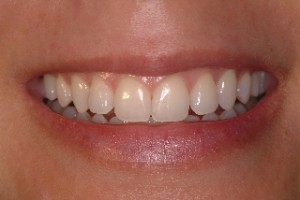
On the other hand, when your gums become unhealthy, they can either recede or turn swollen and red.
 |
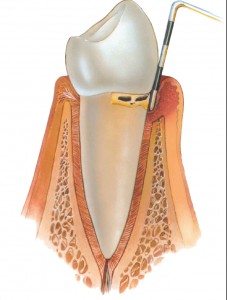 |
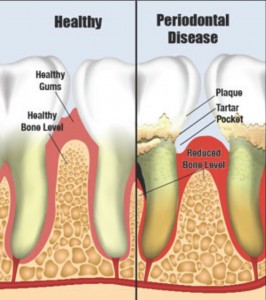 In later stages, the supporting bone is destroyed and your teeth will shift, loosen or fall out. These changes not only affect your ability to chew and speak – they also spoil your smile. Keeping your teeth is directly dependent on proper periodontal care and maintenance. Periodontal treatment is necessary when various conditions affect the health of your gums and the part of your jawbone, which holds your teeth in place. Periodontal (gum) disease is caused by an infection started by bacteria, which live in plaque. The disease damages the teeth, gums and jawbone of more than 80% of Americans by age 45 It is the major cause of tooth loss in adults. A variety of treatment methods are used to treat different periodontal disease conditions. If your overall periodontal health needs treatment, your initial therapy will be focused on removing the bacteria that cause disease and teaching you the most appropriate cleaning methods. Subsequent treatment is then directed towards specific problem areas. If your specific periodontal problem is localized and the rest of your mouth is in good health, your treatment appointment should be scheduled soon to prevent further damage.
In later stages, the supporting bone is destroyed and your teeth will shift, loosen or fall out. These changes not only affect your ability to chew and speak – they also spoil your smile. Keeping your teeth is directly dependent on proper periodontal care and maintenance. Periodontal treatment is necessary when various conditions affect the health of your gums and the part of your jawbone, which holds your teeth in place. Periodontal (gum) disease is caused by an infection started by bacteria, which live in plaque. The disease damages the teeth, gums and jawbone of more than 80% of Americans by age 45 It is the major cause of tooth loss in adults. A variety of treatment methods are used to treat different periodontal disease conditions. If your overall periodontal health needs treatment, your initial therapy will be focused on removing the bacteria that cause disease and teaching you the most appropriate cleaning methods. Subsequent treatment is then directed towards specific problem areas. If your specific periodontal problem is localized and the rest of your mouth is in good health, your treatment appointment should be scheduled soon to prevent further damage.
STAGES OF PERIODONTAL DISEASE
Periodontal disease is a progressive and usually painless process in which bacteria living in dental plaque cause an infection in the crevices between your gums and your teeth. It begins with the gingivitis – inflammation of your gums which causes irritation and bleeding. 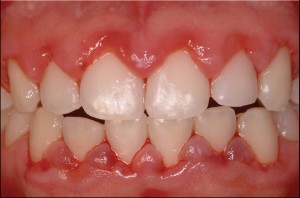
This infection, if left untreated, will ultimately result in the destruction of the bone anchoring your teeth. As the bone is destroyed, often times your tissue will recede, making you look “long in the tooth” 
Left untreated, the disease accelerates and your teeth become loose. This is because you can no longer remove the bacteria as they spread deeper into the crevices (or pockets) between your gums and your teeth. Moderate periodontal disease where there is a moderate amount of bone loss, generally has gum pocket depths measuring 4 to 7 millimeters.  Healthy gums (also called gingival) generally have pocket depths of 3 millimeters or less. Treatment usually consist of deep scaling ( also called root planing) to remove bacterial plaque and tartar ( also called calculus) from under your gums. Occasionally, localized surgical therapy is needed to provide access to the roots of your teeth so the bacteria can be completely removed. Advanced (or severe) periodontal disease, where there is significant bone loss, generally has pocket depths greater than 7 millimeters.
Healthy gums (also called gingival) generally have pocket depths of 3 millimeters or less. Treatment usually consist of deep scaling ( also called root planing) to remove bacterial plaque and tartar ( also called calculus) from under your gums. Occasionally, localized surgical therapy is needed to provide access to the roots of your teeth so the bacteria can be completely removed. Advanced (or severe) periodontal disease, where there is significant bone loss, generally has pocket depths greater than 7 millimeters.  Your gums can become actively infected and your teeth can become loose and may fall out spontaneously. The teeth may shift position and affect your ability to eat. Treatment generally consists of deep scaling, removing hopeless teeth, possibly splinting loose teeth together and localized surgical therapy. Localized surgical therapy may allow better cleaning and slow the progression of the bone destroying disease. Since gum disease can occur at any age, it is best to consult a periodontist once any of the above are recognized or suspected. For more information: links to American Academy of Periodontology (www.perio.org/)
Your gums can become actively infected and your teeth can become loose and may fall out spontaneously. The teeth may shift position and affect your ability to eat. Treatment generally consists of deep scaling, removing hopeless teeth, possibly splinting loose teeth together and localized surgical therapy. Localized surgical therapy may allow better cleaning and slow the progression of the bone destroying disease. Since gum disease can occur at any age, it is best to consult a periodontist once any of the above are recognized or suspected. For more information: links to American Academy of Periodontology (www.perio.org/)
IMPLANT DENTISTRY
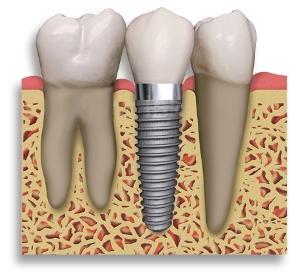 |
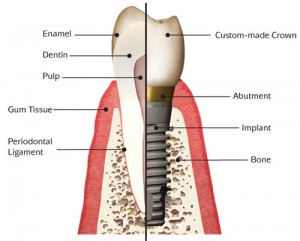 |
A dental implant is an artificial tooth root placed into your jaw to hold a replacement tooth or bridge in place. While high-tech in nature, dental implants are actually more tooth-saving than traditional bridgework, since implants do not rely on neighboring teeth for support. In addition, dental implants are intimately connected with the gum tissues and underlying bone in the mouth. Therefore, they prevent the bone loss and gum recession that often accompanies bridgework and dentures and preserve the integrity of facial features. When teeth are missing, the bone which previously supported these teeth begins to deteriorate. This can result in dramatic changes in your appearance, such as increased wrinkles around the mouth and lips that cave in and lose their natural shape. Since periodontists are the dental experts who specialize in precisely these areas, they are ideal members of your dental implant team. Not only do periodontists have experience working with other dental professionals, they also have the special knowledge, training and facilities that you need to have teeth that look and feel just like your own. Talk with your periodontist to find out if dental implants are an option for you.
For further information, please click on the link below:
American Academy of Periodontology
